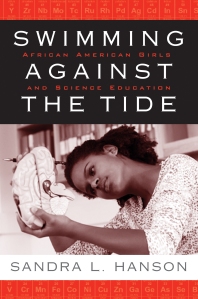 In this blog entry, Sandra Hanson, author of Swimming Against the Tide: African American Girls and Science Education, describes her research providing testimony at the House Subcommittee on “Encouraging the Participation of Females Students in Science, Technology, Engineering and Mathematics Fields.”
In this blog entry, Sandra Hanson, author of Swimming Against the Tide: African American Girls and Science Education, describes her research providing testimony at the House Subcommittee on “Encouraging the Participation of Females Students in Science, Technology, Engineering and Mathematics Fields.”
Statistics on degrees and jobs in science published by the National Science Foundation show progress for women and minorities in science, technology, engineering, and mathematics (STEM). However they also show that a gap remains, especially in science occupations. I am optimistic about the gains, but we must still work on making science more inclusive.
These young women love science. However, when they go into the science classroom, one girl suggests that teachers “look at us like we are not supposed to be scientists.” What do these young girls say about changing the science classroom? They want, for example: better preparation in STEM in the early years and access to advanced STEM tracks in the later years, changes that make science more accessible, better trained and motivated teachers, smaller classes, more work in groups (cooperative learning), more hands-on experiences (and an active laboratory component), more gender and race diversity in science teachers and curriculum (especially text books), high expectations for all students, special programs to encourage women and minorities in science, and more access to mentoring and networking. My research and other research supported by the National Science Foundation suggest that these changes in STEM education would benefit all youth. In the Q and A after the testimony Representative Fudge (D-OH) asked about access to science for girls (and boys) in inner-city schools. I noted in my response a need to equalize resources across school districts. Children unlucky enough to be born in a lower-income school district should not have to deal with science classrooms that lack good teachers, textbooks and equipment.
The committee inquired about other things that might be done to reduce the gender gap in science. I noted some of my research on girls and sport in my testimony. My research shows that sport provides an important resource in enhancing young women’s science access and achievement. It encourages independence, teamwork, and competition – the same traits that tend to be associated with women’s success in the male domain of science. Female athletes have an advantage in science over non-athletes. Young girls who are given an early opportunity to be involved in sport may well be less intimated and more prepared for the culture of science classrooms and work settings. It was encouraging to hear Representatives Ehlers (R-MI) and Fudge (D-OH) as well as Cheryl Thomas (one of the experts providing testimony at the hearing who is President and Founder of Ardmore Associates, LLC) express interest and support for this notion.
When second grade girls and boys are asked to draw a picture of a scientist they often draw a white male who is alone and ominous looking. This is not an attractive image for boys or girls. We need to change the image of science for all youth and importantly we need to make science available to all. If we are to be economically competitive in an age of global markets we need diverse strategies, skills, and competence in STEM. Students in the U.S. (male and female) score behind students from many other countries on math and science exams. We need to improve the quality of our science education system. We know what works. The new practice guide by the National Center for Education Research (“Encouraging Girls in Math and Science”) offers five recommendations for schools and teachers for increasing girls’ participation and interest in science. Guides such as this one need to be integrated in a routine way into U.S. STEM programs.
For more information on Sandra Hanson’s Swimming Against the Tide, visit: http://www.temple.edu/tempress/titles/1904_reg.html
Filed under: african american studies, gender studies, race and ethnicity, sociology, women's studies | Tagged: engineering, mathematics, science, technology | Leave a comment »








